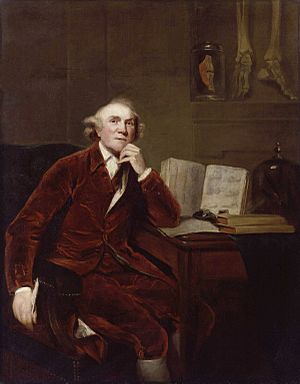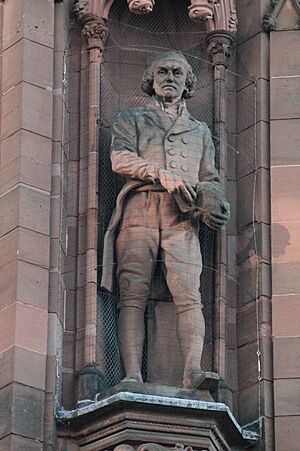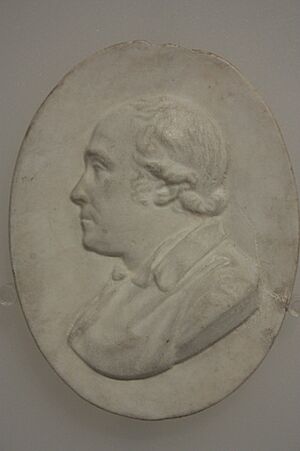John Hunter (surgeon) facts for kids
Quick facts for kids
John Hunter
|
|
|---|---|

Painted by John Jackson, 1813, after Sir Joshua Reynolds, 1786
|
|
| Born | 13 February 1728 Long Calderwood near East Kilbride, Scotland
|
| Died | 16 October 1793 (aged 65) London, England
|
| Nationality | Scottish |
| Education | St Bartholomew's Hospital |
| Known for | Scientific method in medicine Many discoveries in surgery and medicine |
| Medical career | |
| Profession | Surgeon |
| Institutions | St George's Hospital |
| Research | Dentistry, gunshot wounds, ... diseases, digestion, child development, foetal development, lymphatic system |
| Awards | Copley Medal (1787) |
John Hunter FRS (born February 13, 1728 – died October 16, 1793) was a famous Scottish surgeon. He was one of the most important scientists and surgeons of his time.
Hunter believed in careful observation and using a scientific approach in medicine. He taught and worked with Edward Jenner, who created the first smallpox vaccine. Hunter also built a huge collection of animal and human specimens to study anatomy.
He learned about the human body by helping his older brother, William, with dissections. This was at William's anatomy school in London, starting in 1748. John quickly became an expert in anatomy.
He spent some years as an Army surgeon. He also worked with a dentist named James Spence on tooth transplants. In 1764, he opened his own anatomy school in London.
Hunter collected many living animals. He prepared their skeletons and organs for study. This collection grew to nearly 14,000 items. It showed the anatomy of humans and many other vertebrates.
He became a member of the Royal Society in 1767. The Hunterian Society in London is named after him. The Hunterian Museum at the Royal College of Surgeons still keeps his name and his amazing collection.
Contents
Early Life and Learning
Hunter was born at Long Calderwood in Scotland. He was the youngest of ten children. His older brother, William, was also a famous anatomist. As a young boy, John didn't show much interest in school. He helped his brother-in-law as a cabinet-maker.
Becoming an Anatomy Expert
When John was almost 21, he visited William in London. His brother William was a respected anatomy teacher. John started helping William with dissections in 1748. Soon, he was teaching the practical classes by himself.
Some people have suggested that William Hunter and his teacher, William Smellie, were linked to the deaths of pregnant women whose bodies were used for their studies. However, experts on Georgian London life say that the number of pregnant women who died then was not unusually high. A condition called pre-eclampsia, which is common and treatable today, was not understood back then. This condition could explain the deaths.
Hunter also studied blood and how the body reacts to illness. He developed a new idea that inflammation was the body's way of fighting disease, not a disease itself.
Hospital Training
Hunter trained under important surgeons. He studied with William Cheselden at Chelsea Hospital. He also learned from Percival Pott at St Bartholomew's Hospital. Hunter even studied with Marie Marguerite Bihéron, a well-known anatomist who made wax models.
After finishing his training, he worked at St George's Hospital. He was an assistant surgeon from 1756 and then became a full surgeon in 1768.
Army Service
In 1760, Hunter became an Army surgeon. He served on an expedition to the French island of Belle Île in 1761. In 1762, he served with the British Army.
After the Army
Hunter left the Army in 1763. For about five years, he worked with James Spence, a famous London dentist.
In 1764, Hunter opened his own anatomy school in London. He also started his own private surgical practice.
Later Career and Discoveries
In 1768, Hunter became a surgeon at St George's Hospital. He also joined the Company of Surgeons. In 1776, he was appointed surgeon to King George III.
In 1783, Hunter moved to a large house in Leicester Square. This big house allowed him to organize his huge collection. It had nearly 14,000 preparations from over 500 types of plants and animals. He used this collection as a teaching museum.
That same year, he acquired the skeleton of Charles Byrne. Byrne was an Irish giant who was 2.31 meters (7 feet 7 inches) tall. Byrne had asked to be buried at sea. However, Hunter managed to get his skeleton against his wishes. Today, Byrne's skeleton is still at the Hunterian Museum in London.
In 1786, Hunter became a deputy surgeon for the British Army. In 1790, he was made Surgeon General by Prime Minister William Pitt. In this role, he changed how army surgeons were chosen. He made sure they were picked based on their experience and skill, not just who they knew.
John Hunter died in 1793 from a heart attack. This happened after an argument at St George's Hospital about admitting students. He was first buried in London. Later, in 1859, he was reburied in Westminster Abbey. This shows how important he was to the country.
One of his assistants described him as a person who could get angry easily.
Family Life
In 1771, John Hunter married Anne Home. She was a poet whose poems were even set to music by Joseph Haydn. They had four children, but two of them died young. Their daughter, Agnes, married General Sir James Campbell of Inverneill.
Hunter's Impact
In 1799, the government bought Hunter's collection of papers and specimens. They gave it to the Company of Surgeons.
Medical Contributions
Hunter made many important contributions to medicine. For example, in 1790, he performed the first recorded artificial insemination on a woman.
Places Named After Him
Many places are named in his honor. The John Hunter Clinic at the Chelsea and Westminster Hospital in London is one. The John Hunter Hospital in Newcastle, Australia, is another. The Hunterian Neurosurgical Laboratory at Johns Hopkins Hospital is also named after him.
His birthplace in Long Calderwood, Scotland, has been kept as the Hunter House Museum.
See also
 In Spanish: John Hunter para niños
In Spanish: John Hunter para niños



